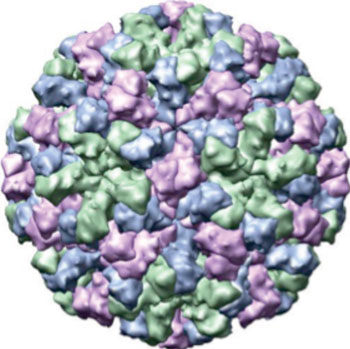Aerosol Spread of Noroviruses Confirmed in Hospital Setting
By LabMedica International staff writers
Posted on 13 May 2015
While noroviruses are known to be spread by direct contact with an infected person or through contact with contaminated feces or vomit, a recent study found indications that they may also be transmitted as an aerosol.Posted on 13 May 2015
Investigators at Université Laval (Québec, Canada) examined the airborne transmission of noroviruses at eight local hospitals and long-term care facilities affected by gastroenteritis outbreaks. They gathered air samples at a distance of one meter from patients, at the doors to their rooms, and at nursing stations.

Image: X-ray crystallographic structure of the norovirus capsid (Photo courtesy of Wikimedia Commons).
Results showed that noroviruses could be detected in the air at six of the eight facilities studied. The viruses were detected in 54% of the rooms housing patients with gastroenteritis, 38% of the hallways leading to their rooms, and 50% of nearby nursing stations. Virus concentrations ranged from 13 to 2,350 particles per cubic meter of air, while a dose of 20 norovirus particles is usually enough to cause gastroenteritis.
In a parallel study the investigators used an aerosol chamber to evaluate the ability of mouse Norovirus MNV-1 to withstand the stress of being spread as an aerosol. The results indicated that this Norovirus preserved its infectivity and integrity when suspended in an aerosol.
Senior author Dr. Caroline Duchaine, professor of science and engineering at Université Laval, said, "The measures applied in hospital settings are only designed to limit direct contact with infected patients. In light of our results, these rules need to be reviewed to take into account the possibility of airborne transmission of noroviruses. Use of mobile air filtration units or the wearing of respiratory protection around patients with gastroenteritis are measures worth testing."
The study was published in the April 21, 2015, online edition of the journal Clinical Infectious Diseases.
Related Links:
Université Laval













